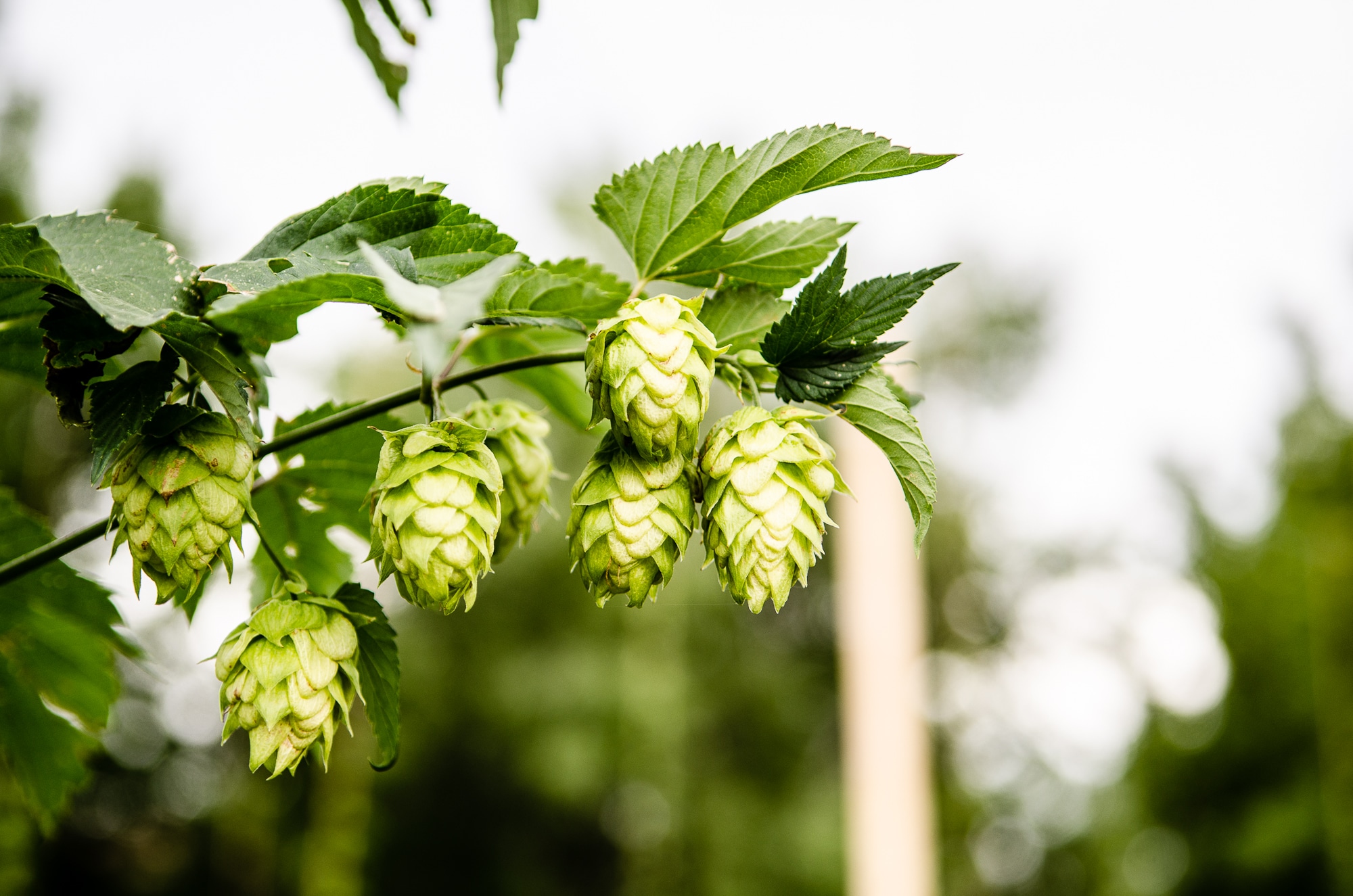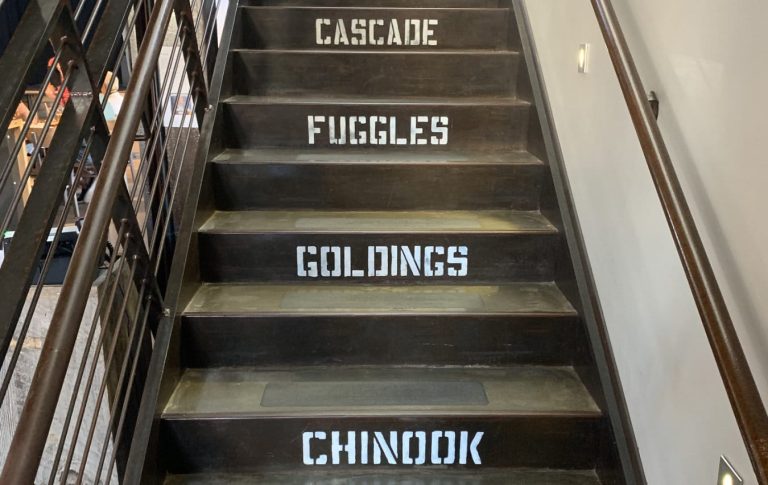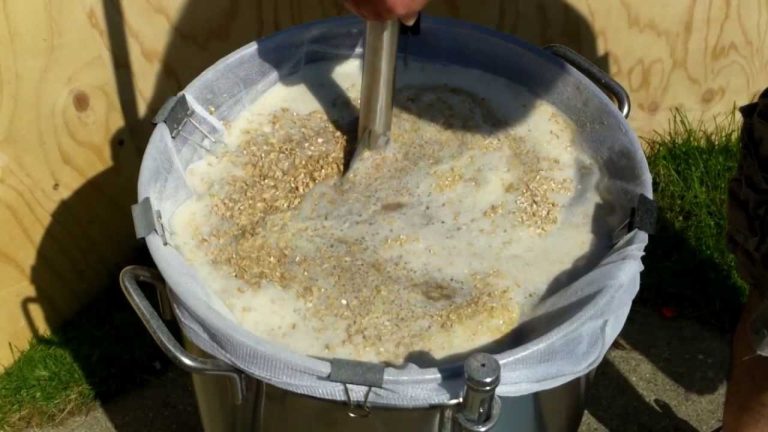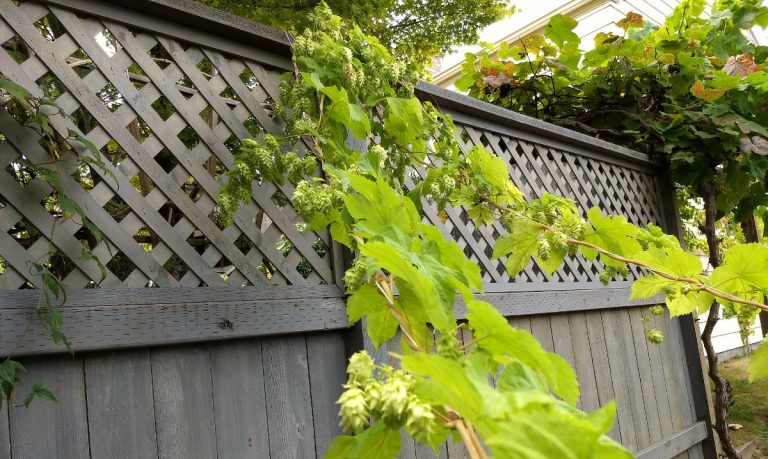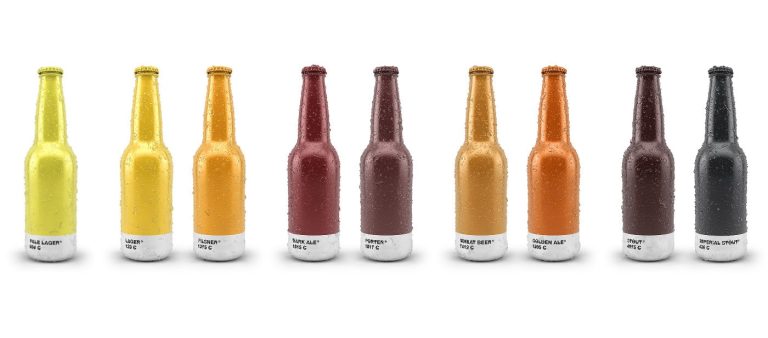The Most Commonly Used IPA Hops
If you’ve read this site for long enough, it should have become obvious that I love IPAs. Well, I am also obsessed with the hops that go into them.
As I started to brew my own beers and stretch into creating my own recipes, I always wondered which hops are commonly paired together in some of my favorite beers.
I decided to go on a scavenger hunt of sorts and find as many hop bills I could for commercial beers that I know taste delicious and run some analysis on them. I was looking for common hop pairings, triplets, and anything else that may jump out at me from the data.
I was able to kick off my list with an article that The Mad Fermentationist put together from back in 2013. I then added to the 40 or so he had by going down through my Untappd check-ins (best to worst ratings) and added another 270 or so.
Untapped has a treasure trove of data. Using their service, I was also able to also jump around to about 10 major zip codes in the US (NYC, Chicago, SD, etc.) and look at their most popular beers in real time. Many of the beers in my list are from popular “new age” breweries such as Stone, Other Half, Dancing Gnome, Treehouse, Trillium, Hill Farmstead, etcetera. I used these breweries purposefully, as I wanted to make sure this as current and relatable as possible for 2020.
[adthrive-in-post-video-player video-id=”wrw5vYHf” upload-date=”2022-05-05T18:58:02.000Z” name=”Top Five Hops in IPAs” description=”” player-type=”default” override-embed=”default”]Read More: The Most Popular Hops in Use Today
When creating the list, I followed a couple rules:
- No Single hop beers. While tasty, these weren’t going to help me much if I was looking for pairs of hops. (Note: I did however relent and add a section below that listed out the most common hops for single hopped beers.)
- I wasn’t going to make any assumptions. If the description said “Citrus” I did not mark down “Citra” instead.
- I didn’t differentiate between different hop additions. There simply isn’t enough information around for that.
- The beer styles had to be either an IPA or pale ale. By my rough estimation, about 1/5 of the list were pale ales while the rest were either West Coast, New England or American IPAs.
- I did not combine CTZ and Columbus. If the recipe called for Columbus, I used that term instead of aggregating under CTZ.
- I combined the names of the hops that have been renamed recently, including Denali->Sultana, Stella->Ella and Equinox->Ekuanot.
I ended up getting the hop bills of 335 beers. Now, there is no way of knowing if some of these descriptions ignored a bittering hop or two (I’m sure some did). However, since most flavor and aroma comes from the dry hop – I figured I was safe using the beer descriptions on Untapped since breweries love to tout their dry hop skills there.
Most Common Multi-hop IPA/Pale Ale Hops
Out of those 335 beers, I found a total of 92 unique hops being used. You won’t be too surprised with the top of this list, but it isn’t supposed to be the main course. It is, however, a good primer for what we are going to discuss later on, and it is interesting to see some newer hops moving up the list in popularity.
My two cents on the list:
- I am a bit surprised to see how high in the list Simcoe and Centennial are. I knew they were often used in IPAs, but I didn’t realize they were both top-5 worthy.
- I really expected Galaxy to be higher in the list, but this is due to the shortage of the varietal that has been occurring since 2017.
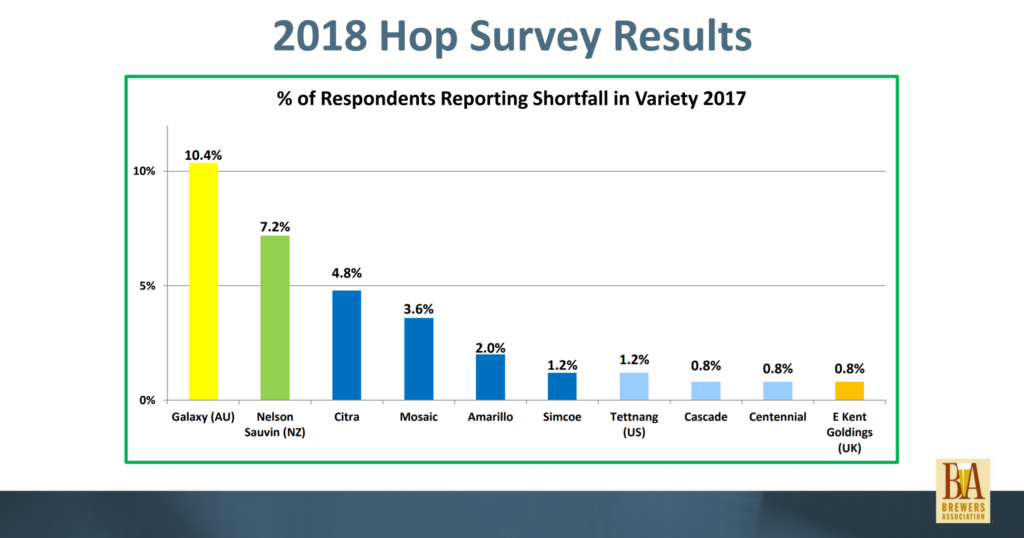
- New Zealand and Australian hops are taking over the IPA market. Motueka and Galaxy weren’t even listed on the 2013 list from The Mad Fermentationist, and now they are within the top 15.
| Hops | Count |
|---|---|
| Citra | 160 |
| Mosaic | 135 |
| Simcoe | 89 |
| Amarillo | 68 |
| Centennial | 55 |
| Cascade | 45 |
| Columbus | 42 |
| El Dorado | 40 |
| Chinook | 38 |
| Galaxy | 37 |
| Idaho 7 | 20 |
| Vic Secret | 18 |
| Azacca | 18 |
| Motueka | 17 |
| Ekuanot (formerly Equinox) | 17 |
| Nelson Sauvin | 15 |
| Nugget | 11 |
| Sabro | 10 |
| Strata | 9 |
| Hallertau Blanc | 8 |
| Warrior | 8 |
| Ahtanum | 8 |
| Summit | 8 |
| Sultana (formerly Denali) | 7 |
| CTZ | 7 |
| Mandarina Bavaria | 7 |
| Calypso | 6 |
| Crystal | 6 |
| Cashmere | 6 |
| Pacific Jade | 5 |
| Magnum | 5 |
| Huell Melon | 5 |
| Falconer’s Flight | 4 |
| Ella (formerly Stella) | 4 |
| Topaz | 4 |
| Enigma | 4 |
| Lotus | 4 |
| Bravo | 4 |
| Lemondrop | 3 |
| Glacier | 3 |
| Palisade | 3 |
| Wai-iti | 3 |
| Waimea | 3 |
(1 each) Phoenix, Raku, Samba, Dr. Rudi, African Queen, Laurel, Mt. Hood, Caliente, Barbe Rouge, Vanguard, Saaz, Southern Star, Styrian Golding, HBC 431, HBC 342, 6277, HBC 692, Grungiest, Santiam, Tettnang, Hallertau, Southern Cross, Northern Brewer, Moutere, Challenger, Willamette, Golding, Aurora, Michigan Copper
Single Hop Varieties
Citra
The Citra hop is a high alpha acid hop with a strong, yet smooth floral and citrus aroma and flavor. It has specific aroma descriptors that include grapefruit, citrus, peach, melon, lime, gooseberry, passion fruit and lychee. These tropical fruit fla…
Alpha Acids: 10-15%
Beta Acids: 3-4.5%
Cohumulone: 20-35%
Country: USA
Purpose: Dual
Total Oils: 1.5-3 ml/100g
Profile: citrus, grapefruit, peach, melon, lime, floral, gooseberry, passion fruit & lychee
Many commercial IPAs or pale ales are formulated to showcase one hop at a time as a rotating series. Other Half and Dancing Gnome do this a lot, and so do many of the other breweries around me. I took an informal tally of the hops typically used as a ‘single-hop’ within a particular beer, and to no one’s surprise, Citra came out on top again. Here are the others, in descending order:
- First Place: Citra
- Second Place (tied): Simcoe, Nelson Sauvin, Mosaic and Galaxy
- Third Place (all others): Cashmere, Idaho 7, Motueka, Amarillo, Denali, El Dorado, Vic Secret, Wai-iti, Strata, Centennial
Any hop that is used as the one and only inside a beer will need to be a dual-purpose hop in order to add both bittering and aroma/flavor… which all of these are. You can also see how many of the really, really juicy hops are at the top here with Galaxy, Nelson and Mosaic joining Citra.
Finding Perfect Hop Pairings & Combinations
I dusted off my old python programming skills and whipped up a short script that looked at all the different possible hop pairs within each of the recipes, and counted them. I first looked at pairs, then triplets, then quadruplets.
There were over 1,050 different combinations of hops within the data I had. Over 74% of the popular hoppy beer recipes utilized either two or three hops.
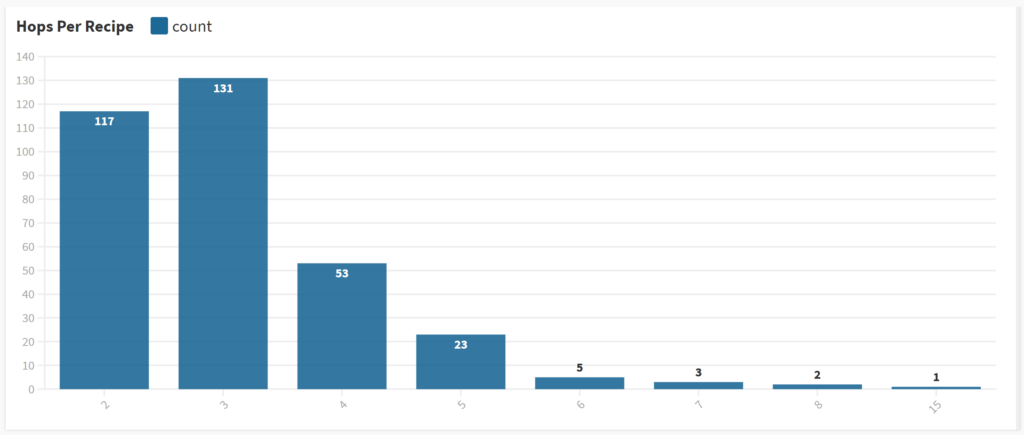
The top hop combination pairs are unsurprisingly dominated by Citra, Simcoe and Mosaic. I was a bit surprised by the lack of Southern Hemisphere hops outside from a couple mentions of Galaxy, but it may just be lack of easy access by the breweries themselves. Washington State is much closer than the Outback.
Here are the top twenty pairs of hops. This list went on and on for another 1,030 rows, but only 16% of them had more than 1 instance of the pair. Each count is a combination of hops from within a specific beer, but it does not mean that those were the only two hops used.
| Hop #1 | Hop #2 | Count |
|---|---|---|
| Citra | Mosaic | 77 |
| Citra | Simcoe | 30 |
| Amarillo | Simcoe | 30 |
| Amarillo | Citra | 29 |
| Centennial | Simcoe | 29 |
| Mosaic | Simcoe | 27 |
| Citra | El Dorado | 23 |
| Citra | Galaxy | 21 |
| Cascade | Centennial | 20 |
| Centennial | Columbus | 18 |
| Amarillo | Centennial | 18 |
| Centennial | Chinook | 17 |
| El Dorado | Mosaic | 17 |
| Cascade | Chinook | 17 |
| Amarillo | Mosaic | 16 |
| Galaxy | Mosaic | 16 |
| Chinook | Simcoe | 16 |
| Cascade | Simcoe | 15 |
| Centennial | Citra | 14 |
| Chinook | Columbus | 14 |
| Citra | Columbus | 14 |
Interactive Chart
Here is an interactive circle hierarchy graph I put together with the same data. You can click into each hop variety and see the commonly used hops with it. This chart shows all combinations, so you are able to view every pair found, unlike the table I listed above.
Hop Triplets
When you look at common triplet combinations of hops, you get a table that doesn’t have much diversity at the top.
| Hop #1 | Hop #2 | Hop #3 | Count |
|---|---|---|---|
| Amarillo | Centennial | Simcoe | 13 |
| Citra | Mosaic | Simcoe | 11 |
| Cascade | Centennial | Chinook | 11 |
| Citra | El Dorado | Mosaic | 11 |
| Citra | Galaxy | Mosaic | 10 |
| Centennial | Columbus | Simcoe | 10 |
| Amarillo | Citra | Mosaic | 9 |
| Centennial | Chinook | Columbus | 9 |
| Cascade | Centennial | Simcoe | 9 |
| Cascade | Centennial | Columbus | 8 |
| Centennial | Citra | Simcoe | 8 |
| Amarillo | Citra | Simcoe | 8 |
| Centennial | Chinook | Simcoe | 8 |
| Amarillo | Cascade | Centennial | 7 |
| Cascade | Chinook | Columbus | 7 |
| Amarillo | Cascade | Simcoe | 6 |
| Cascade | Chinook | Simcoe | 6 |
| Chinook | Columbus | Simcoe | 6 |
You have to dig in a little bit deeper to get into the interesting stuff. For instance, the Chinook+Cascade combo didn’t make it into the top dual pairings, but is quite prominent in the triplets. They both have prominent citrus profiles, but are quite different outside that.
Another interesting tidbit is that while Citra+Mosaic was our top pairing by a mile, the third hop added to it is very evenly distributed between Simcoe, El Dorado, Galaxy and Amarillo.
Finally, when “C” hops are often referenced as the perfect hops for IPAs, they aren’t kidding. The American hops mix of Cascade, Centennial, Columbus, Chinook and Citra were a part of 92.5% of the top 100 triplet combinations. As much as brand new hops hit the market on a yearly basis, the staples still remain as the backbone of most of the IPAs we all enjoy.
Quadruplet Hop Combos
Just for giggles, I wanted to see the most common hops when looking at a combination of four at a time. The numbers started dwindling pretty significantly, so I am not sure how useful this chart is, but I wanted to share it in case it would help someone in the future with their recipe planning.
| Hop #1 | Hop #2 | Hop #3 | Hop #4 | Count |
|---|---|---|---|---|
| Amarillo | Cascade | Centennial | Simcoe | 5 |
| Cascade | Centennial | Chinook | Simcoe | 5 |
| Centennial | Chinook | Columbus | Simcoe | 4 |
| Amarillo | Cascade | Chinook | Simcoe | 4 |
| Amarillo | Centennial | Chinook | Simcoe | 4 |
| Amarillo | Centennial | Citra | Simcoe | 4 |
| Cascade | Centennial | Chinook | Columbus | 4 |
| Amarillo | Centennial | Columbus | Simcoe | 4 |
| Amarillo | Cascade | Centennial | Chinook | 4 |
| Amarillo | Cascade | Centennial | Columbus | 3 |
| Amarillo | Centennial | Magnum | Simcoe | 3 |
| Cascade | Centennial | Columbus | Simcoe | 3 |
| Chinook | Columbus | Simcoe | Warrior | 3 |
| Amarillo | Citra | Mosaic | Simcoe | 3 |
Interestingly, many of the new age hops that have unique flavors like Mosaic, Galaxy and any of the other NZ or AU hop are typically not used in large complex hop bills. This is probably because since their flavors and aromas are so complex and unique, they would get overshadowed in recipes that also feature lots of other hops. You can see this also happening with our single-hop list above as many of these new hops are featured as the only hop in the beer, showcasing it instead of masking it with others.
When you start seeing more than 4 hops used in a recipe, then you know that most of those will be used in dry hopping. The best hops for dry hopping will always be aroma or dual-purpose hops. The different kinds of hops are aroma, bittering and dual-purpose, which means they can be used for adding either aroma or bittering (or both) qualities to beer.
